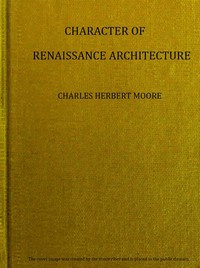Character of Renaissance Architecture by Charles Herbert Moore
"Character of Renaissance Architecture" by Charles Herbert Moore is a scholarly examination of the architectural styles that emerged during the Renaissance, written in the early 20th century. The work seeks to analyze the essence of Renaissance architecture, contrasting it with the preceding Gothic style and exploring the influences that shaped it, particularly in relation to moral, social, and aesthetic conditions of the time. Through detailed study and illustrations, the book intends to
provide insights into how Renaissance architecture, often regarded as a reflection of classic ideals, also embodies unique characteristics influenced by Venetian and Florentine cultural elements. The opening of the text introduces the author's preface, in which he explains the purpose behind his exploration of Renaissance architecture. Moore argues that previous assessments of the architectural advancements during this period often overlook the profound differences from medieval architecture. He discusses how Renaissance architecture was heavily influenced by the spirit of the time—reflecting moral decay and luxury, as well as the revival of classical antiquity—but also points to the inherent contradictions and individualism that characterized this period. Thus, the groundwork is laid for a critical analysis of various architectural achievements, beginning with the notable dome of Florence, which serves as a focal point for discussing innovations and deviations from classical construction principles. (This is an automatically generated summary.)
Read or download for free
| How to read | Url | Size | |||
|---|---|---|---|---|---|
| Read now! | https://www.gutenberg.org/ebooks/69619.html.images | 775 kB | |||
| EPUB3 (E-readers incl. Send-to-Kindle) | https://www.gutenberg.org/ebooks/69619.epub3.images | 10.9 MB | |||
| EPUB (older E-readers) | https://www.gutenberg.org/ebooks/69619.epub.images | 10.9 MB | |||
| EPUB (no images, older E-readers) | https://www.gutenberg.org/ebooks/69619.epub.noimages | 292 kB | |||
| Kindle | https://www.gutenberg.org/ebooks/69619.kf8.images | 11.1 MB | |||
| older Kindles | https://www.gutenberg.org/ebooks/69619.kindle.images | 11.0 MB | |||
| Plain Text UTF-8 | https://www.gutenberg.org/ebooks/69619.txt.utf-8 | 571 kB | |||
| Download HTML (zip) | https://www.gutenberg.org/cache/epub/69619/pg69619-h.zip | 10.0 MB | |||
| There may be more files related to this item. | |||||
Similar Books
About this eBook
| Author | Moore, Charles Herbert, 1840-1930 |
|---|---|
| LoC No. | 05033509 |
| Title | Character of Renaissance Architecture |
| Original Publication | United Kingdom: The Macmillan Company,1905. |
| Note | Reading ease score: 55.4 (10th to 12th grade). Somewhat difficult to read. |
| Contents | Introduction -- The dome of Florence -- Church architecture of the Florentine renaissance -- The dome of St. Peter's -- Church architecture of the Roman renaissance -- Palace architecture of the Florentine renaissance -- Palace architecture of the Roman renaissance -- Church architecture of the renaissance in north Italy -- Palace architecture of the renaissance in north Italy -- Architectural carving of the renaissance -- Architecture of the early renaissance in France -- Lescot and De l'Orme -- Architecture of the renaissance in England. I. Elizabethan art -- Architecture of the renaissance in England. II. Jones and Wren -- Conclusion. |
| Credits | Tim Lindell, Albert László, Karin Spence and the Online Distributed Proofreading Team at https://www.pgdp.net (This file was produced from images generously made available by The Internet Archive/American Libraries.) |
| Language | English |
| LoC Class | NA: Fine Arts: Architecture |
| Subject | Architecture, Renaissance |
| Category | Text |
| EBook-No. | 69619 |
| Release Date | Dec 23, 2022 |
| Copyright Status | Public domain in the USA. |
| Downloads | 144 downloads in the last 30 days. |
| Project Gutenberg eBooks are always free! | |

